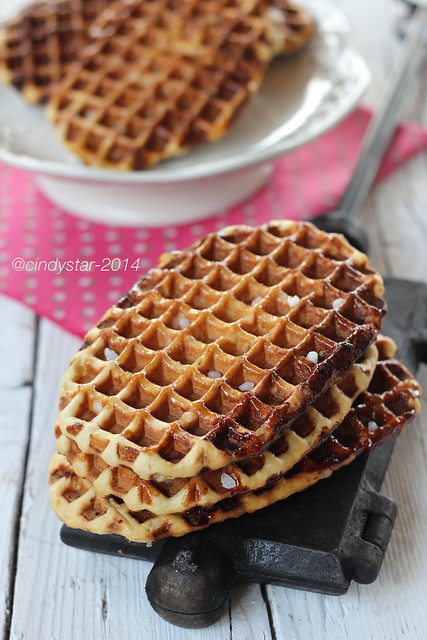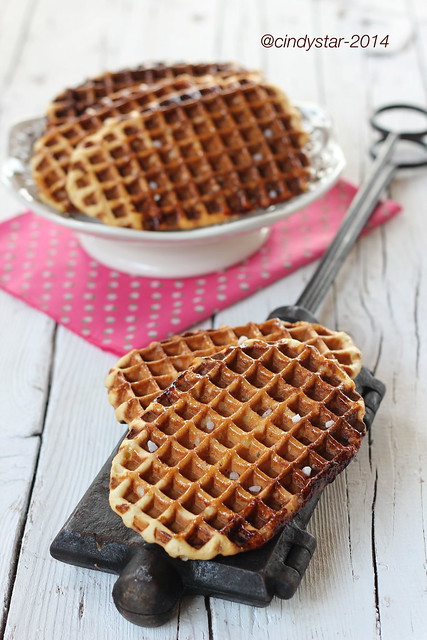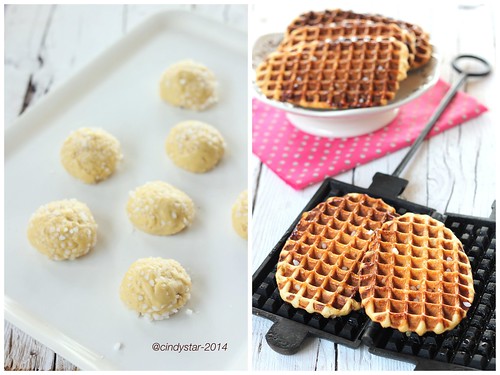la ricetta in italiano qui
I simply love (j'adore) French flea markets and when I am there I never miss a single chance to visit one. I love to spend the day putting my eyes on every single stall, trying to find the strangest and oldfest things, it's so relaxing and exciting at the same time!
And then, as I like to be able to use these things properly washed and cleaned thoroughly, thinking who knows how many hands will be used, how much food will be cooked, and how much more will be helpful!
In one of my last tour I found an ancient fer à gaufre at a very cheap price and the temptation was too strong to resist as I never made or ate a waffle in my life! So what better to inaugurate it for our Culinary ABC of the European Community trip in Belgium.
And then, as I like to be able to use these things properly washed and cleaned thoroughly, thinking who knows how many hands will be used, how much food will be cooked, and how much more will be helpful!
In one of my last tour I found an ancient fer à gaufre at a very cheap price and the temptation was too strong to resist as I never made or ate a waffle in my life! So what better to inaugurate it for our Culinary ABC of the European Community trip in Belgium.
As to wikipedia, a gaufre/waffle is a leavened batter or dough cooked between two plates, patterned to give a characteristic size, shape and surface impression. There are many variations based on the type of iron and recipe used, with over a dozen regional varieties in Belgium alone.
Waffles are eaten throughout the world, particularly in Belgium, France, Netherlands, Scandinavia, and the United States.
Interesting to read about history and evolution through the centuries, it seems even it was also present in the kitchens of ancient Greece.
The different kind of dough and the variety of models, shapes and motifs of the plates (called challe - waffier - fer à waffles - waffles à moule - gaufrier) shows many variations of waffles exist.
According to the General dictionary of ancient and modern French cuisine, the Gaufre is a native of Brabant province, one of the nine Belgian provinces in 1830, centered on its capital Brussels.
According to the General dictionary of ancient and modern French cuisine, the Gaufre is a native of Brabant province, one of the nine Belgian provinces in 1830, centered on its capital Brussels.
Belgian Waffles are of two types: those in Brussels have a perfectly rectangular outline and a dough made of milk, water, butter, eggs, flour, sugar, yeast and flavoring (often vanilla). They are not very sweet waffle , usually dusted with powdered sugar or served with whipped cream (and/or fruit and ice cream).
Liège waffles have honeycomb edges, and the dough is made with flour, a few eggs, milk, butter, yeast, a pinch of salt, vanilla sugar and granulated sugar, the characteristic sucre perl , a particular type of sugar very coarse, hard, opaque white, that does not melt at temperatures. They are definitely sweeter than those of Brussels and usually eaten without any accompaniment.
In Belgium waffles are especially welcome as gifts on Sint Maartens Dag, St. Martin's Day , November 11th, served with powdered sugar, syrup, cream, ja , fruit, walnuts, hazelnuts, almonds, chocolate, butter, but also with salty food as fish, cheese, meat.
Brussels waffles are prepared with an egg-white-leavened or yeast-leavened batter, traditionally an ale yeast; occasionally both types of leavening are used together. They are lighter, crisper and have larger pockets compared to other European waffle varieties, and are easy to differentiate from Liège Waffles by their rectangular sides. In Belgium, most waffles are served warm by street vendors and dusted with confectioner's sugar, though in tourist areas they might be topped with whipped cream, soft fruit or chocolate spread. Variants of the Brussels waffles – with whipped and folded egg whites cooked in large rectangular forms – date from the 18th century. However, the oldest recognized reference to Gaufres de Bruxelles (Brussels Waffles) by name is attributed from 1842/43 to Florian Dacher, a Swiss baker in Ghent, Belgium, who had previously worked under pastry chefs in central Brussels. Philippe Cauderlier would later publish Dacher's recipe in the 1874 edition of his recipe book La Pâtisserie et la Confiture. Maximilien Consael, another Ghent chef, had claimed to have invented the waffles in 1839, though there's no written record of him either naming or selling the waffles until his participation in the 1856 Brussels Fair.
Liège Waffle is a richer, denser, sweeter, and chewier waffle, the most famous contemporary Belgian variety.
Native to the greater Wallonia region of Eastern Belgium – and alternately known as gaufres de chasse (hunting waffles) – they're an adaptation of brioche bread dough, featuring chunks of pearl sugar which caramelize on the outside of the waffle when baked. It is the most common type of waffle available in Belgium and prepared in plain, vanilla and cinnamon varieties by street vendors across the nation.
It is said to have been invented in the 18th century by the chef of the prince-bishop of Liège. However, no German, French, Dutch or Belgian cookbook got references in this period and with any denomination, nor are there waffle recipes with the characteristic ingredients of Liège Waffles, the brioche dough and pearl sugar pearl.
Only in 1814 Antoine Beauvilliers publish a recipe in Art du Cuisiner with a brioche dough and sucre cassé (coarse sugar) as topping, not yet mixed in the dough. Antonin Carême, the famous Parisian pastry chef, is the first to incorporate gros sucre in different waffles mentioned in his book Le Maitre d'Hotel Français, 1822. Then, in 1834, Leblanc publishes a complete recipe for waffles grêlées (coarse waffles), where gros sucre is mixed into the dough. But for a complete recipe for Liège Waffles we have to wait until 1921.
The French wikipedia page shows as many as 37 types of gaufres with so many different names: interesting and funny to read them all and discover even the smallest differences between them.
Gauff’ au suc is the name in the local slang.
Gauff’ au suc is the name in the local slang.
Serving 8 waffles:
300 g all-purpose flour
an egg
half a small glass warm milk
a tsp dry yeast
2 tbs sugar or sugar cane
60 g soft butter
a pinch of salt
2 t liquid vanilla
100 g of granulated sugar (sucre perlé )
300 g all-purpose flour
an egg
half a small glass warm milk
a tsp dry yeast
2 tbs sugar or sugar cane
60 g soft butter
a pinch of salt
2 t liquid vanilla
100 g of granulated sugar (sucre perlé )
Soak the yeast in the milk as instructed.
Mix flour with the milk and yeast mixture, egg, sugar, salt and vanilla until everything is well amalgamated, if necessary add a tablespoon of milk. Shape into a ball and let rest covered for half an hour.
Then add the butter, one piece at a time and mix well until well absorbed and the dough is homogeneous, if necessary add a tablespoon of flour.
Divide the dough into 8 pieces, weighing about 70/75 g each.
Roll each piece into granulated sugar, gently pressing to get some sugar inside, and roll into small balls. Let rise covered for an hour.
Thoroughly warm up the plate on gas, place a ball of dough onto the chessboard, close the plate and cook a couple of minutes per side, turning the plate.
Mix flour with the milk and yeast mixture, egg, sugar, salt and vanilla until everything is well amalgamated, if necessary add a tablespoon of milk. Shape into a ball and let rest covered for half an hour.
Then add the butter, one piece at a time and mix well until well absorbed and the dough is homogeneous, if necessary add a tablespoon of flour.
Divide the dough into 8 pieces, weighing about 70/75 g each.
Roll each piece into granulated sugar, gently pressing to get some sugar inside, and roll into small balls. Let rise covered for an hour.
Thoroughly warm up the plate on gas, place a ball of dough onto the chessboard, close the plate and cook a couple of minutes per side, turning the plate.
Easier if you have an electric waffle maker.
This recipe also goes to Susan's weekly YeastSpotting.




3 commenti:
bella ricetta la mia è un pò diversa,felice serata
grazie Cinzia, la ricetta è perfetta! Bacioni
Grazie a te, Lucia, bacionissimi! :-)
Posta un commento
grazie della visita e gentilmente firma sempre i tuoi commenti!
thanks for passing by and please sign up your comments!